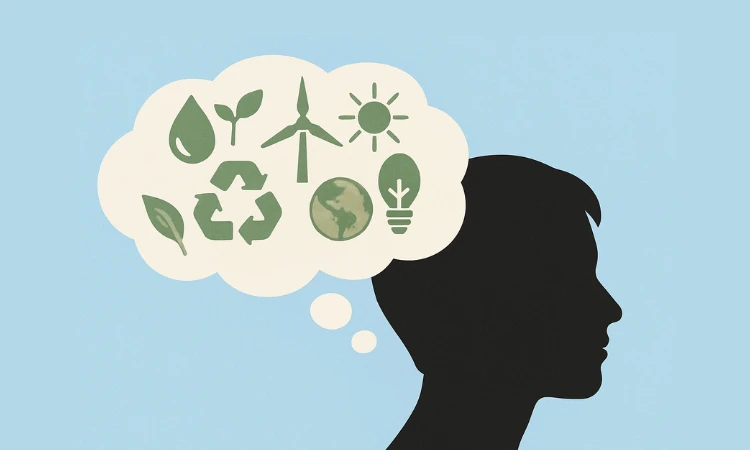How to Talk About Sustainability: 6 Practical Tips
We’ve all been there. A family dinner, a chat with a friend, or a workplace discussion where a comment about sustainability brings the conversation to a halt. Despite good intentions, these talks can quickly stall, bumping up against deeply held beliefs, emotions, and personal identities.
The problem isn’t a lack of facts; it’s a failure to connect. Fortunately, by borrowing a few lessons from psychology, we can transform these difficult exchanges from standoffs into moments of collaborative problem-solving.
Here are six key insights to help you have the productive sustainability conversations you’re seeking.
1. Start with Shared Values, Not Divisive Facts
Humans are wired to defend their social identities. If a message feels like an attack on “who I am” or “what my group believes,” we instinctively shut down.
Psychologists call this identity-protective cognition. To avoid it, link your point to a broad, unifying values like family well-being, financial common sense, local pride, or fairness. This affirms the listener’s core identity instead of threatening it.
Example: Instead of leading with a statistic about emissions, try: “I’ve been thinking a lot about how we can ensure our town has clean air and water for our kids to enjoy for years to come.”
Remember, affirmation lowers the listener’s defences, making them more receptive to new information.
2. Choose the Right Moment and Mood
Our brains have limited bandwidth. We process complex, emotionally charged topics best when our minds are free and our mood is neutral to positive.
Avoid launching into a discussion about climate policy during a stressful commute or after a long, tiring day. Instead, choose moments when the mental load is low and emotions aren’t running high.
Example: Choose a relaxed weekend walk, a casual coffee break, or while working together on a simple task.

3. Foster Collaboration with Curiosity, Not Judgment
When people feel their freedom to choose is being threatened, they push back.
This is a powerful psychological reflex known as reactance. To overcome this, instead of telling someone what to do, use open-ended questions to invite self-reflection and autonomy. You will fine this approach can be incredibly effective.
Example: Ask, “What are your thoughts on electric cars?” or “What are some of the challenges you see in reducing plastic waste at home?”
Studies show that reflective listening doubles the odds that someone will voice their own reasons for change, which are always more persuasive than yours.
4. Acknowledge Complexity & Celebrate Small Wins
When people realise their daily actions conflict with their environmental ideals, they experience an uncomfortable mental tension called cognitive dissonance.
If you imply they must achieve perfection overnight, they’re likely to resolve that tension by abandoning the ideal altogether. Acknowledge the trade-offs and celebrate incremental progress.
Example: Say, “It’s tough to avoid all plastic, but switching to refillable cleaners is a fantastic start!”
This approach keeps the dissonance manageable, making the next step feel achievable, not overwhelming.

5. Know When to Hit the Pause Button
Heated dialogue triggers the body’s threat response. The heart rate rises, cortisol floods the system, and the prefrontal cortex (the seat of rational thought) goes offline.
Pushing through is pointless. Learn to recognise the early signs of emotional flooding in others (and yourself!), such as a rising voice, tense posture, or repetitive arguments.
What to say: “I can feel this is important to both of us and things are getting a bit heated. How about we take five minutes and come back to this? I want to make sure I understand your perspective.”
Remember, even a brief pause allows the rational brain to re-engage.
6. Lead by Example to Make It Normal
People often look to others to determine what is normal and acceptable behaviour. Psychologists call these descriptive norms.
Visible, effortless-seeming actions, like carrying a reusable coffee cup or biking to work, send a powerful message: “This is what people like us do.” Research consistently shows that norm-based cues are far more effective at inspiring change than guilt or shaming.
Tip: Narrate your small wins aloud to plant a normative seed without preaching. “I was surprised by how much switching to these reusable bags cut down on my plastic use.” This makes your actions both visible and relatable.

Talking Sustainability: Key Takeaways
Each of these strategies is backed by decades of research into how we persuade, change, and connect.
The key is shifting our goal from winning an argument to building a bridge. When we align our message with fundamental human psychology, respecting identity, autonomy, and emotion, we transform sustainability talks from potential minefields into shared explorations.
Every respectful conversation is a seed. With enough seeds and plenty of patience, we can grow the cultural shift our planet needs.
To support you further with those sustainability conversations, we also recommend you check our the below resources here at Greener Insights:
What is Sustainability: Fundamentals Explained
How to Build a Sustainability Mindset That Lasts
40 Fascinating Facts About Sustainability
Finally, want more practical ideas and sustainability tips?
Then check in here at Greener Insights for regular updates, or follow us on our social media channels:







